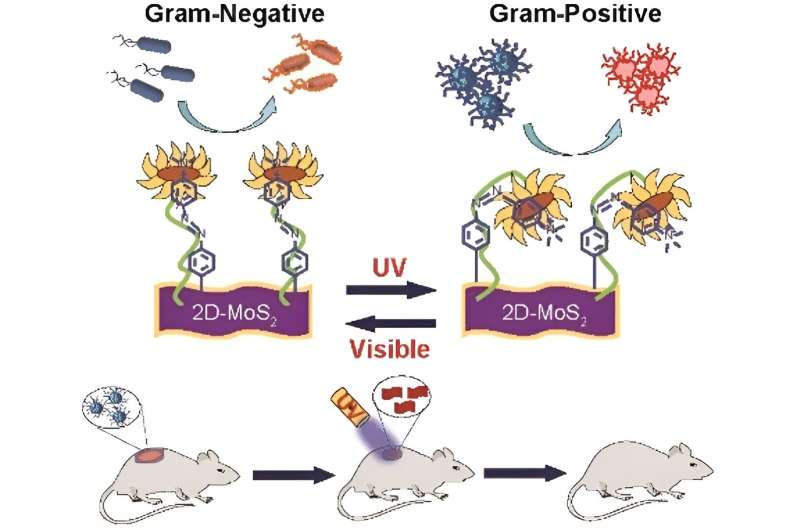This article has been reviewed according to Science X's editorial process and policies. Editors have highlighted the following attributes while ensuring the content's credibility:
fact-checked
peer-reviewed publication
trusted source
proofread
Nanomaterial with 'light switch' kills Gram-negative or Gram-positive bacteria

Health care-associated infections are a common problem in suppurating wound care, as is the rise in multi-drug resistant bacteria. In order to effectively and selectively combat bacterial infections, a team of researchers has developed a bactericidal nanomaterial equipped with a photochemical "light switch" that can be directed either against Gram-positive or Gram-negative bacteria.
As the team reports in their study published in Angewandte Chemie, its effectivity against MRSA can be extended to other selective bacterial infections.
Antibiotic-resistant infections have become an urgent public health concern, particularly in hospital settings. Many of the bacterial species in question are widespread in nature, but can cause much more serious, sometimes untreatable, infections in immunocompromised patients.
Bactericidal materials offer a new approach to combating health care-associated infections that does not rely on antibiotics. Mrinmoy De and colleagues from the Indian Institute of Science in Bengaluru, India, have now succeeded in producing a UV-visible-light-responsive nanomaterial that can be switched to target either Gram-positive or Gram-negative bacteria.
Both bacteria types have very different outer membrane structures and compositions. Gram-positive bacteria, including methicillin-resistant Staphylococcus aureus (MRSA), have a bacterial membrane majorly composed of peptidoglycans.
In contrast, Gram-negative bacteria, including Pseudomonas aeruginosa, another health care-associated bacterium with problematic resistance to broadband antibiotics, has both inner and outer membrane mainly composed of phospholipids with a thin peptidoglycan layer. "It is important to achieve strain-selective bactericidal activity," says De.
To achieve a bactericidal agent that could selectively interact with both chemical surfaces, the team designed a functionalized nanomaterial made of molybdenum disulfide (MoS2) with azobenzene moieties to which positively charged quaternary amino groups were attached. While MoS2 is a bactericide and the quaternary amino groups allow membrane depolarization, the azobenzene moieties introduce a light-driven switch in the nanostructure from an elongated trans into a curved cis form to create selective surface interactions.
The team used several chemical probes and optical measurements to determine that both the cis and trans forms of the nanomaterial killed bacteria, albeit in very different ways.
For the Gram-negative P. aeruginosa, the trans form depolarized the bacterial membrane and pierced it thoroughly. This allowed the MoS2 nanomaterial to generate intracellular reactive oxygen species and kill the bacteria. Conversely, the Gram-positive MRSA strain responded to the cis form more effectively. In this case, the cell wall was damaged and ruptured by specific interactions.
By simply "flipping" the UV switch from the trans ground state to the cis state, the team was able to control selectivity for either bacterial type. They demonstrated the efficacy of their nanomaterial by successfully healing MRSA-infected wounds in mice models. The wounds completely closed after 10 days when treated with the cis reagent, faster than the usual antibiotic treatment with vancomycin.
More information: Jagabandhu Sahoo et al, Photo‐Controlled Gating of Selective Bacterial Membrane Interaction and Enhanced Antibacterial Activity for Wound Healing, Angewandte Chemie International Edition (2023). DOI: 10.1002/anie.202314804
Journal information: Angewandte Chemie International Edition , Angewandte Chemie
Provided by Wiley





















